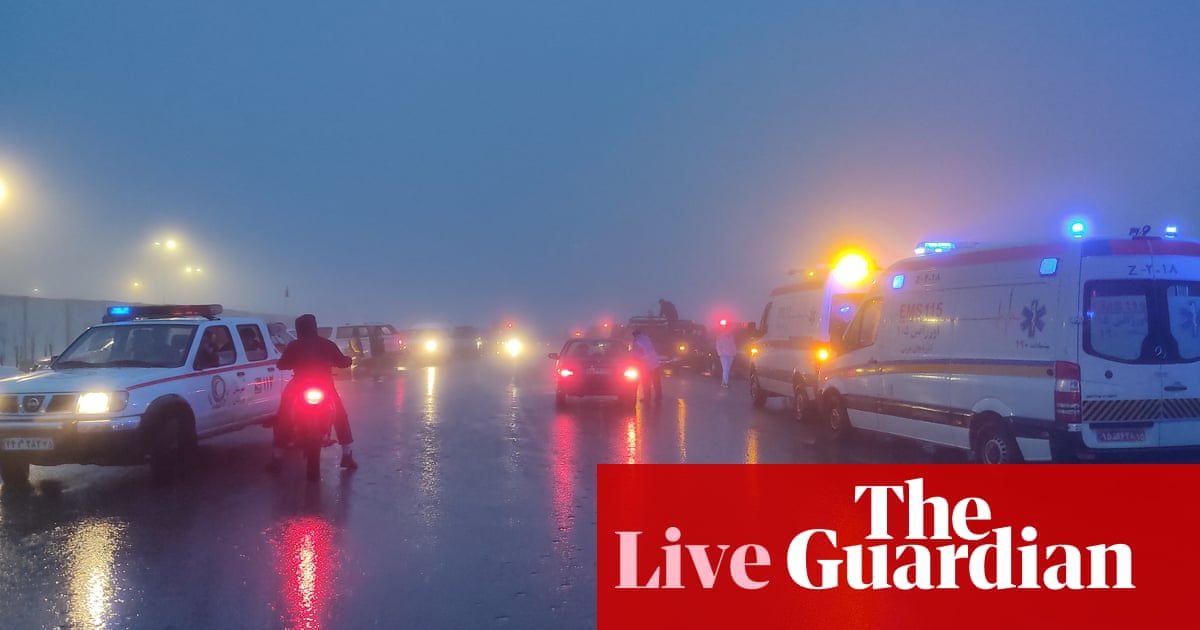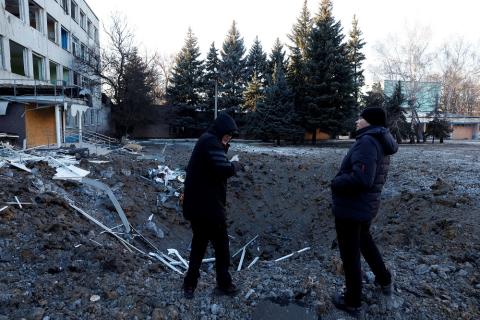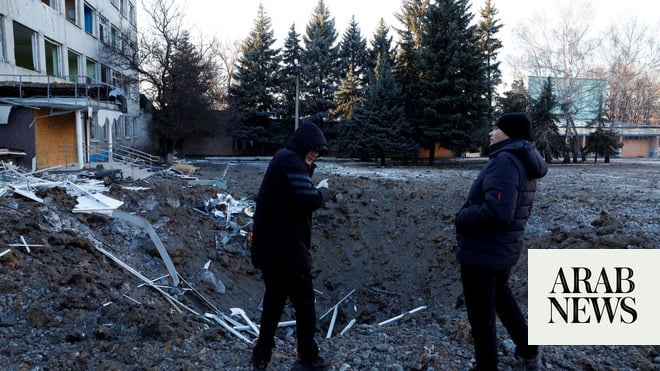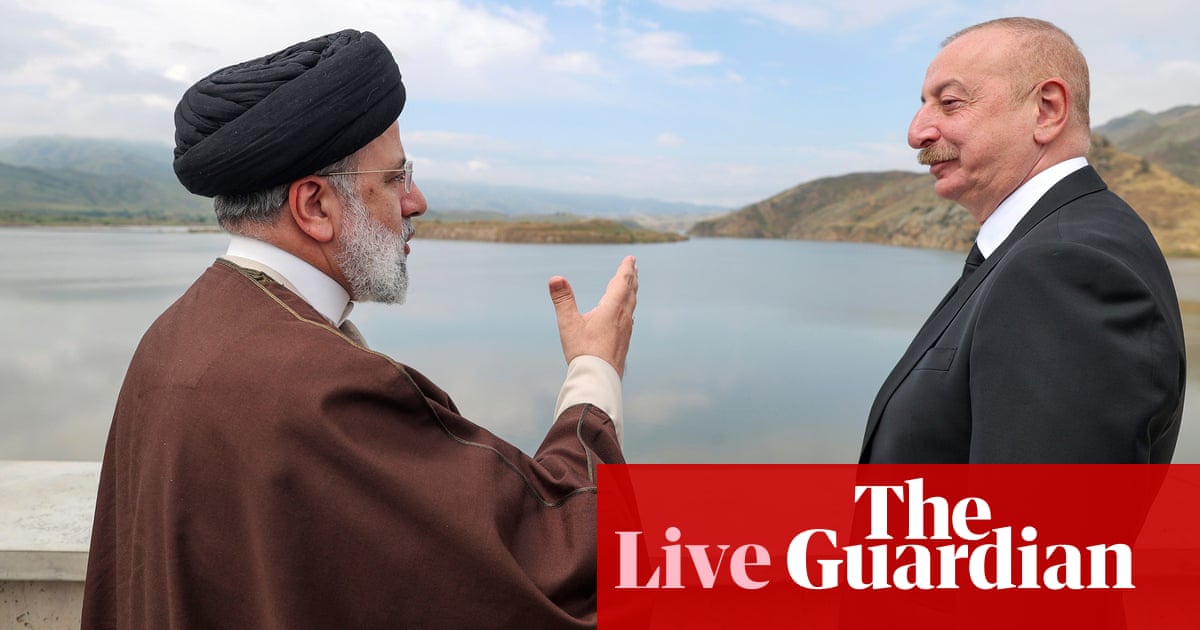
"No sign of life" at crash site, state TV says
Iranian state television is reporting that there is “no sign of life” at the helicopter crash site, according to Associated Press and Reuters.
Reuters said the head of the Red Crescent, Pir Hossein Kolivand, had told state TV there was no sign of life at the scene.
The site was across a steep valley and rescuers had yet to reach it, state media reported.
An Iranian official also told Reuters that the helicopter carrying the president was completely burned and that expectations are low that he has survived the crash.
There has been no official statement from the Iranian government yet.
Reuters has put together some background on the Bell 212 helicopter in which Raisi was believed to have been travelling when it crashed. It is the civilian version of the ubiquitous Vietnam War-era UH-1N “Twin Huey,” and is in wide use globally by both governments and private operators:
What are the helicopter’s origins?
Bell Helicopter (now Bell Textron, a division of Textron Inc ) developed the aircraft for the Canadian military in the late 1960s as an upgrade of the original UH-1 Iroquois. The new design used two turboshaft engines instead of one, giving it greater carrying capacity. The helicopter was introduced in 1971 and quickly adopted by both the United States and Canada, according to U.S. military training documents.
What is it used for?
As a utility helicopter - the UH in its military designation represents those words - the Bell 212 is meant to be adaptable to all sorts of situations, including carrying people, deploying aerial firefighting gear, ferrying cargo and mounting weapons.
The Iranian model that crashed on Sunday was configured to carry government passengers. Bell Helicopter advertises the latest version, the Subaru Bell 412, for police use, medical transport, troop transport, the energy industry and firefighting. According to its type certification documents with the European Union Aviation Safety Agency, it can carry 15 people, including the crew.
Who uses it?
Non-military organisations that fly the Bell 212 include Japan’s Coast Guard; law enforcement agencies and fire departments in the US; Thailand’s national police; and many others. It is not clear how many Iran’s government operates, but its air force and navy have a total of 10, according to FlightGlobal’s 2024 World Air Forces directory.
Have there been any other incidents involving the Bell 212?
The most recent fatal crash of a Bell 212 was in September 2023, when a privately operated aircraft crashed off the coast of the United Arab Emirates, according to the Flight Safety Foundation, a non-profit focusing on aviation safety. The most recent Iranian crash of the type was in 2018, killing four people, according to the organisation’s database.
The helicopter crash comes just as Iran’s relations with Israel reach a new pitch of danger.
Last month the two countries exchanged fire, sparked by an Israeli attack on the Iranian consulate in Damascus, and more broadly by Iran’s support for proxy groups willing to fight Israel, including Hamas and Hezbollah.
Any new president will have to make big decisions over Iran’s nuclear programme.
On 9 May, Kamal Kharrazi, the supreme leader’s foreign policy advisor and former Iranian foreign minister, said Iran will consider a doctrinal shift to nuclear deterrence if Israel attacks what Iran says are civilian nuclear sites.
Rafael Grossi, the head of the UN nuclear inspectorate the IAEA, warned Iran to end the loose talk about developing a nuclear weapon, saying it was disturbing.
"No signs of life" detected at crash site, head of Red Crescent says
Reuters is now carrying the full quote from the head of Iran’s Red Crescent, Pir Hossein Kolivand. He told state TV:
With the discovery of the crash site, no signs of life have been detected among the helicopter’s passengers.
Iranian state TV said images from the site showed the helicopter had crashed into a mountain peak, according to Reuters.
Images published by state media including the Fars news agency shared drone images of what appeared to be the burnt out wreckage of the helicopter.
"No sign of life" at crash site, state TV says
Iranian state television is reporting that there is “no sign of life” at the helicopter crash site, according to Associated Press and Reuters.
Reuters said the head of the Red Crescent, Pir Hossein Kolivand, had told state TV there was no sign of life at the scene.
The site was across a steep valley and rescuers had yet to reach it, state media reported.
An Iranian official also told Reuters that the helicopter carrying the president was completely burned and that expectations are low that he has survived the crash.
There has been no official statement from the Iranian government yet.
If Raisi has died it will add to the sense of a country already in political transition. A new hardline parliament was only just elected on 1 March in which turnout for some of the elections fell below 10%, and was overall presented as reaching a nationwide turnout of only41% – a record low.
Reformist or moderate politicians were either disqualified or soundly beaten leaving a new and, as yet, untested division in parliament between traditional hardliners and an ultra-conservative group known as Paydari or the Steadfastness Front.
The effective exclusion of reformists from political participation in parliament for the first time since 1979 adds to the sense of a country in uncharted waters.
The cumulative disruption also comes at a time when Iran can ill afford such uncertainty as it faces western challenges over its nuclear programme, a dire economy and tense relations with other Middle Eastern states, especially with regard to relations with Israel and the US.
The possible loss of Hossein Amir-Abdollahian, the foreign affairs minister, in the helicopter crash only adds to a sense of instability for a country that prided itself on control and predictability. His most likely successor is his deputy, Ali Bagheri, but hardliners may regard him as too willing to negotiate with the west over Iran’s nuclear programme.
Although Iran has not lost a president in office since the revolution in 1979, the country has a clear formal system for succession in which the first vice-president – currently Mohammad Mokhber – takes charge.
Few regard Mokhber, a banker and former deputy governor of the Khuzestan province, as presidential material. A new president should be elected within 50 days, giving the supreme leader and his entourage relatively little time to select someone that will not only become president at such a critical time, but also will be in a strong position succeed Ayatollah Ali Khamenei himself.
The immediate challenge of any new leader would be to control not just internal dissent, but the factional demands within the country to take a tougher line with the west and draw closer to Russia and China.
Wreckage of helicopter has been sighted, head of Iranian Red Crescent says
The wreckage of the helicopter carrying President Raisi has been sighted, the head of the Iranian Red Crescent has told Iranian state television.
Pir Hossein Kolivand said rescue teams were on their way to the helicopter and could see it from about two kilometres away, according to Associated Press.
“We can see the wreckage and the situation does not look good,” Reuters quoted Kolivand as saying.
The news came shortly after a Turkish drone reportedly spotted a heat source which authorities believed to be the wreckage of the helicopter. The Turkish news agency Anadolu said the coordinates had been shared with Iranian authorities and the Red Crescent said it was sending its teams to the location.
The area where the helicopter is said to have crashed is in the mountains near Iran’s border with Azerbaijan, from where he was travelling back after inaugurating a new dam there.
Reuters has put together a list of reactions from around the world, with Iranian ally Russia among those expressing concern and offering to help search for the president. Others also offered help or well wishes, while the US merely said that President Joe Biden was “closely following reports”. Here’s a rundown of reactions from around the world:
TURKEY
“I convey my best wishes to our neighbour, friend and brother Iranian people and government, and I hope to receive good news from Mr Raisi and his delegation as soon as possible,” President Recep Tayyip Erdoğan said in a post on X. Turkey’s disaster and emergency management authority said in a statement that Iran had requested a night vision search-and-rescue helicopter from Turkey.
CHINA
Beijing is “deeply concerned over the ‘hard landing’” of Raisi’s helicopter, the foreign ministry’s spokesperson said in a statement. Beijing “hopes President Raisi and the others aboard are safe and sound. We are closely following the situation and will provide all necessary support and assistance for Iran’s rescue efforts.”
RUSSIA
“Russia is ready to extend all necessary help in the search for the missing helicopter and the investigation of the reasons for the incident,” foreign ministry spokeswoman Maria Zakharova said in a comment carried by Russia’s Ria news agency. State media later reported that Russia was sending emergency equipment including two planes and helicopter and about 60 personnel.
US
“We are closely following reports of a possible hard landing of a helicopter in Iran carrying the Iranian president and foreign minister,” a State Department spokesperson said in a statement. A spokesperson for President Biden, Karine Jean-Pierre, told reporters on board Air Force One that the president had been briefed on the situation. She did not elaborate.
EUROPEAN COMMISSION
The European commissioner for crisis management, Janez Lenarcic, said the commission had activated its satellite mapping service to aid search efforts, following a request for assistance from Iran. The Copernicus Emergency Management Service provides mapping products based on satellite imagery.
AZERBAIJAN
“Today, after bidding a friendly farewell to the (visiting) President of the Islamic Republic of Iran, Ebrahim Raisi, we were profoundly troubled by the news of a helicopter carrying the top delegation crash-landing in Iran,” President Ilham Aliyev said in Twitter post. “Our prayers to Allah Almighty are with President Ebrahim Raisi and the accompanying delegation. As a neighbour, friend, and brotherly country, the Republic of Azerbaijan stands ready to offer any assistance needed.”
KUWAIT
“We are closely following with concern the reports regarding the helicopter carrying the Iranian president and his accompanying delegation. Kuwait expresses its wishes for their safety and its support for the Islamic Republic of Iran in this critical situation,” the foreign ministry said in a statement.
SAUDI ARABIA
“The Kingdom of Saudi Arabia affirms that it stands by the Islamic Republic of Iran during these difficult circumstances and is prepared to provide any assistance the Iranian services need,” the foreign ministry said in a statement. It also said the Saudi government was following news reports regarding Raisi’s helicopter with “great concern”.
QATAR
“We express the State of Qatar’s deep concern regarding the Iranian president’s helicopter experiencing a difficult landing incident,” a spokesperson for the foreign ministry said in a statement. “We affirm the State of Qatar’s readiness to provide all forms of support in the search for the Iranian president’s aircraft. We express the State of Qatar’s wishes for the safety of the Iranian president, the foreign minister and their companions.”
IRAQ
The Iraqi government said in a statement it had instructed its interior ministry, the Red Crescent and other relevant bodies to offer help to neighbouring Iran in the search mission.
Footage from Iran shows rescuers walking through thick fog as they search for the president’s helicopter. In this video, Raisi can also be seen on his visit to Azerbaijan, where he was inaugurating a dam with his Azerbaijani counterpart Ilham Aliyev.
In an early morning update, Iran’s state-run news agency Irna has said that a commander from the country’s elite Revolutionary Guards Corps has confirmed the detection of a heat source by a Turkish drone that is believed to be the wreckage of the president’s helicopter.
Rescue teams including from the military are combing the area, which Irna described as “rocky” and “hilly”, and have narrowed their search to a radius of 2 kilometres.
Four teams from Iran’s Red Crescent Society (IRCS) are near the crash site, Irna reported citing the head of IRCS operations, Razieh Alishvandi, but have had difficulty in approaching further due to poor weather conditions.
Earlier, IRCS chief Pirhossein Koulivand, who is leading the search and rescue operation, said that bad weather conditions and the impassability of the area were hampering the operation.
Iranians have been praying for the president, while expressions of concern come in from around the world
One Tehran citizen, a 29-year-old journalist who only gave her name as Vakili, told the news agency AFP she “feared” the worst and said it recalled previous tense moments in recent years.
“I hope they are okay and that they are found,” she said.
“It’s a strange feeling, like we felt before with Haj Qasem Soleimani,” she said, referring to revered Revolutionary Guards commander who was killed in a 2020 US drone strike in Baghdad.
“I am deeply saddened,” said another resident of the capital, a private sector employee named Hadi. “We hope that he [Raisi] and his companions are found in good health.”
One group of men knelt on the side of the street clasping strands of prayer beads and watched a video of Raisi praying, some of them visibly weeping.
“If anything happens to him we’ll be heartbroken,” said one of the men, Mehdi Seyedi. “May the prayers work and may he return to the arms of the nation safe and sound.”
Turkish drone has identified "source of heat" suspected to be helicopter wreckage – report
A Turkish drone has identified a “source of heat suspected to be wreckage of helicopter carrying Iranian President Raisi”, Turkey’s state-run news agency Anadolu has reported in a post on X.
Turkey had shared the coordinates with Iranian authorities, Anadolu reported.
There was no immediate comment or confirmation of the report from the Iranian side but the Irna news agency reported that rescuers were rushing to the scene.
The coordinates listed in the footage put the site about 20 kilometres (12 miles) south of the Azerbaijan-Iranian border on the side of a steep mountain.
Earlier today Iran’s state-run news agency Irna published images that it said show the helicopter carrying President Raisi as it took off from near the border with Azerbaijan on Sunday.
Travelling with him were foreign minister Hossein Amirabdollahian, the governor of Iran’s East Azerbaijan province and other officials and bodyguards, Irna reported.
Irna said Raisi was flying in a US-made Bell 212 helicopter.
Iran flies a variety of helicopters in the country, but international sanctions make it difficult to obtain parts for them.
Its military air fleet also largely dates back to before the 1979 Islamic Revolution. The photograph published by Irna shows a helicopter with a blue-and-white paint scheme previously seen in published photographs.
Who is Ebrahim Raisi?
Ebrahim Raisi is a hardliner who was instrumental in the last few years in steering Iran back towards the more uncompromising beliefs of the Islamic Republic’s revolutionary founders.
A supporter of deeply conservative values on the domestic front, in terms of foreign policy, Raisi also carved out an increasingly aggressive stance, and it was on his watch that Tehran opted to launch its recent unprecedented missile and drone strike against Israel bringing the two countries into direct and open conflict for the first time.
While he was elected president in June 2021, having represented himself as the best person to fight corruption and Iran’s economic problems, Raisi had long occupied important positions in Iran, including an alleged key role in the so-called Death Committee responsible for executing thousands of prisoners in the 1980s – a claim he has denied.
Born in 1960 into a clerical family in Mashdad, Raisi was a child of the revolution that overthrew the Shah after he had travelled to Qom to attend a Shia seminary at the age of 15, following in his father’s footsteps.
While still a young student, he joined the mass protests against the western-backed Shah in 1979 that would lead to the Islamic Revolution under the guidance of Ayatollah Ruhollah Khomeini, a cleric until his dramatic return from exile in France.
In the turbulent first years of the Islamic Revolution, the young Raisi continued with his studies at the Shahid Motahari University in Tehran, where he received a doctorate in Islamic jurisprudence and law.
Joining the judiciary, Raisi, aged just 25 – like many other young men of his generation – would find himself catapulted into important office, in his case as the deputy prosecutor of Tehran.
It was while still in that role, say human rights groups, that he became one of four judges sitting on the infamous Death Committee, a secret tribunal set up in 1988 to retry thousands of prisoners, many of them members of the Mujahedin-e Khalq group.
The Iranian helicopter crash comes at a time when the country, faced by unprecedented external challenges, was already bracing itself for a change in regime with the expected demise in the next few years of its 85-year-old supreme leader, Ayatollah Ali Khamenei.
In the country’s hydra-headed leadership where power is spread in often opaque ways between clerics, politicians and army, it is the supreme leader, and not the president, that is ultimately decisive.
The presidency, however loyal to the supreme leader – and Iranian president Ebrahim Raisi is considered very loyal to Khamenei – is often cast in the role as a useful scapegoat helping the supreme leader to avoid criticism. That certainly became the fate of Raisi’s predecessor Hassan Rouhani who became a punchbag for decisions taken elsewhere.
In recent months Raisi, elected president in 2021 but in practice handpicked by the supreme leader, has been mentioned as a possible successor to Khamenei. His death, if confirmed, would instead clear a thorny path for Khamenei’s son, Mojtaba Khamenei.
The choice is made by an 88-strong “assembly of experts”, and Raisi’s departure would certainly increase the chances of a hereditary succession in Iran, something many clerics oppose as alien to Iran’s revolutionary principles.
Full report: rescuers search for crashed helicopter carrying president and foreign minister
A helicopter carrying the Iranian president, Ebrahim Raisi, and his foreign minister crashed on a fog-covered mountainside, with search and rescue teams rushing to the area as state media called for nationwide prayers.
State TV reported that the helicopter had been found on Sunday evening, well after dark, and quoted an official as saying that at least one passenger and one crew member had been in contact with rescuers.
Still, details were scant and sometimes conflicting, including Iranian Red Crescent rescuers later saying no helicopter had been found.
With no published information of whether the president was alive or dead, the country’s supreme leader, Ayatollah Ali Khamenei – who holds ultimate power in the Islamic Republic – sought to reassure the nation.
Iranians should not worry or be anxious, he said, adding: “No disruption will occur in Iran’s state affairs.”
An Iranian official, however, had told earlier Reuters that the lives of Raisi and the foreign minister, Hossein Amir-Abdollahian – who was travelling with him – were “at risk following the helicopter crash”. They added: “We are still hopeful, but information coming from the crash site is very concerning.”
Opening summary
Hello and welcome to the Guardian’s live coverage of the search for Iranian President Ebrahim Raisi after a helicopter crash.
The Iranian leader was travelling in a mountainous area of East Azerbaijan province with foreign minister Hossein Amir-Abdollahian following a visit to neighbouring Azerbaijan to inaugurate a dam when the crash happened.
Iranian state media blamed bad weather for the crash, which was also described initially by media as a “hard landing”, and said the conditions were complicating rescue efforts.
There have been conflicting reports on whether the helicopter has been found.
Here are the key developments:
Iranian state TV reported that the helicopter had been found by search teams. There was no update on the condition of those onboard. However, Iran’s Red Crescent later denied the state TV report. The location of the helicopter is still unknown.
The incident, which involved one helicopter in a convoy of three, was described by Iranian state television as an accident.
An unnamed Iranian official told Reuters that the lives of the president and his foreign minister were “at risk” after a “crash” as it was crossing mountain terrain in heavy fog.
An unnamed Iranian official told state media that contact had been made on several occasions with a passenger and a crew member, but there have been no further updates.
Three rescue workers searching for the crashed helicopter were reported missing by the Red Crescent but were later accounted for. A spokesperson said the search and rescue operation will slow down as the weather is expected to get “severely cold” soon with more rain forecast. Other media reported that the rain was turning to snow.
Raisi was travelling in Iran’s East Azerbaijan province. State TV described the area of the helicopter incident as being near Jolfa, a city on the border with Azerbaijan. The president had been in Azerbaijan earlier on Sunday to inaugurate a dam with the country’s president Ilham Aliyev. The dam is the third one that the two nations have built on the Aras River.
Iran’s army chief of staff, Maj Gen Mohammad Bagheri, said all army resources would be used for the search and rescue operations, state TV reported. Bagheri said military personnel along with the Revolutionary Guards and police had deployed teams to the area.
Iraq has instructed its interior ministry, the Red Crescent and other relevant bodies to offer help to neighbouring Iran and assist in the search. Turkey, Russia, Saudi Arabia, Qatar and the United Arab Emirates also offered support.
Iranian Supreme Leader Ayatollah Ali Khamenei, who holds ultimate power, sought to reassure Iranians, saying there would be no disruption to state affairs.








